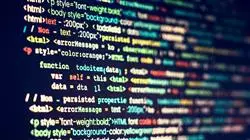University certificate
The world's largest faculty of information technology”
Why study at TECH?
Acquire the fundamental know-how on Computing and Programming Languages and how to apply it successfully in the development of IT projects, in a highly competitive Professional master’s degree"

This Professional master’s degree focuses on the fundamentals of programming and data structure, algorithms and complexity, as well as advanced algorithm design, advanced programming, language processors and computer graphics, among other topics related to this area of computer science.
This Professional master’s degree provides students with specific tools and skills to successfully develop their professional career in the broad environment of Computing and Programming Languages. It works on key competencies such as knowledge of the day-to-day reality and work in different IT areas and develops responsibility for the monitoring and supervision of work, as well as specific skills within this field.
Additionally, as it is a 100% online Professional master’s degree students are not constrained by fixed timetables or the need to commute to another physical location, rather, they can access the contents at any time of the day, balancing their professional or personal life with their studies.
The teaching team of this Professional master’s degree in Computing and Programming Languages has carefully selected each of the topics of this course to offer the student a study opportunity as complete as possible and always linked to current events.
An exceptional opportunity to learn, in a comfortable and straightforward way, the mathematical knowledge and processes necessary to carry out excellent computer programming"
This Professional master’s degree in Computing and Programming Languages contains the most complete and up-to-date program on the market. The most important features include:
- Case studies presented by experts in Computing and Language
- The graphic, schematic, and practical contents which they contain, provide scientific and practical information on the disciplines that are essential for professional practice
- Practical exercises where a self-assessment process can be undertaken to improve learning
- Special emphasis on innovative methodologies in Computing and Language
- Theoretical lessons, questions to the expert, debate forums on controversial topics, and individual reflection assignments
- Content that is accessible from any fixed or portable device with an internet connection
A Professional master’s degree that owes its effectiveness to the most valued educational technology in the market, with audiovisual and study systems that will allow you to learn in a faster and more comfortable way"
Its multimedia content, developed with the latest educational technology, will allow the professional a situated and contextual academic experience, that is to say, a simulated environment that will provide an immersive refresher designed to prepare the student for real situations.
This program is designed around Problem-Based Learning, whereby the professional must try to resolve the different professional practice situations that arise during the academic year. For this, the professional will have the help of an innovative, interactive video system made by recognized and experienced experts in Computing and Programming Languages.
We place at your disposal extensive and clear didactic materials, which incorporate all the current topics of interest for the professional who wants to advance in Computing and Programming Languages"

A program of high educational impact that will allow you to tailor the workload to your needs, combining flexibility and intensity"
Syllabus
The structure of the contents has been created in such a way that the knowledge is assimilated in a progressive way, achieving a growth trajectory that will lead you to excellence in your profession.

All the areas of interest that you need to master in order to work confidently and successfully in Computing and Programming Languages, gathered together in a top-quality syllabus"
Module 1. Programming Fundamentals
1.1. Introduction to Programming
1.1.1. Basic Computer Structure
1.1.2. Software
1.1.3. Programming Languages
1.1.4. Computer Application Life Cycle
1.2. Algorithm Design
1.2.1. Problem Solving
1.2.2. Descriptive Techniques
1.2.3. Algorithm Elements and Structure
1.3. Program Elements
1.3.1. C++ Origin and Features
1.3.2. Development Environment
1.3.3. Concept of Program
1.3.4. Types of Fundamental Data
1.3.5. Operators
1.3.6. Expressions
1.3.7. Statements
1.3.8. Data Input and Output
1.4. Control Statements
1.4.1. Statements
1.4.2. Branches
1.4.3. Loops
1.5. Abstraction and Modularity: Functions
1.5.1. Modular Design
1.5.2. Concept of Function and Utility
1.5.3. Definition of a Function
1.5.4. Execution Flow in the Call of a Function
1.5.5. Function Prototypes
1.5.6. Results Return
1.5.7. Calling Functions: Parameters
1.5.8. Parameter Passing According to Reference and Value
1.5.9. Scope Identifier
1.6. Statistical Data Structures
1.6.1. Arrays
1.6.2. Matrices Polyhedra
1.6.3. Searching and Sorting
1.6.4. Chaining: I/O Functions for Chains
1.6.5. Structures: Unions
1.6.6. New Types of Data
1.7. Dynamic Data Structures: Pointers
1.7.1. Concept. Definition of Pointer
1.7.2. Pointer Operators and Operations
1.7.3. Pointer Arrays
1.7.4. Pointers and Arrays
1.7.5. Chain Pointers
1.7.6. Structure Pointers
1.7.7. Multiple Indirection
1.7.8. Function Pointers
1.7.9. Function, Structure and Array Passing as Function Parameters
1.8. Files
1.8.1. Basic Concepts
1.8.2. File Operations
1.8.3. Types of Files
1.8.4. File Organization
1.8.5. Introduction to C++ Files
1.8.6. Managing Files
1.9. Recursion
1.9.1. Definition of Recursion
1.9.2. Types of Recursion
1.9.3. Advantages and Disadvantages
1.9.4. Considerations
1.9.5. Recursive-Iterative Conversion
1.9.6. Recursion Stack
1.10. Testing and Documentation
1.10.1. Program Testing
1.10.2. White Box Testing
1.10.3. Black Box Testing
1.10.4. Testing Tools
1.10.5. Program Documentation
Module 2. Data Structure
2.1. Introduction to C++ Programming
2.1.1. Classes, Constructors, Methods and Attributes
2.1.2. Variables
2.1.3. Conditional Expressions and Loops
2.1.4. Objects
2.2. Abstract Data Types (ADT)
2.2.1. Types of Data
2.2.2. Basic Structures and ADTs
2.2.3. Vectors and Arrays
2.3. Lineal Data Structures
2.3.1. ADT List Definition
2.3.2. Linked and Doubly Linked Lists
2.3.3. Ordered Lists
2.3.4. Lists in C++
2.3.5. ADT Stack
2.3.6. ADT Queue
2.3.7. Stack and Queue in C++
2.4. Hierarchical Data Structures
2.4.1. ADT Tree
2.4.2. Routes
2.4.3. N-ary Trees
2.4.4. Binary Trees
2.4.5. Binary Search Trees
2.5. Hierarchical Data Structures: Complex Trees
2.5.1. Perfectly Balanced Trees or Minimum Height Trees
2.5.2. Multi-path Trees
2.5.3. Bibliographical References
2.6. Priority Heaps and Queues
2.6.1. ADT Heaps
2.6.2. ADT Priority Queues
2.7. Hash Tables
2.7.1. ADT Hash Table
2.7.2. Hash Functions
2.7.3. Hash Function in Hash Tables
2.7.4. Redistribution
2.7.5. Open Hash Tables
2.8. Graphs
2.8.1. ADT Graph
2.8.2. Types of Graph
2.8.3. Graphical Representation and Basic Operations
2.8.4. Graph Design
2.9. Algorithms and Advanced Concepts on Graphs
2.9.1. Problems with Graphs
2.9.2. Path Algorithms
2.9.3. Search or Path Algorithms
2.9.4. Other Algorithms
2.10. Other Data Structures
2.10.1. Sets
2.10.2. Parallel Arrays
2.10.3. Table of Symbols
2.10.4. Tries
Module 3. Algorithm and Complexity
3.1. Introduction to Algorithm Design Strategies
3.1.1. Recursion
3.1.2. Divide and Conquer
3.1.3. Other Strategies
3.2. Algorithm Efficiency and Analysis
3.2.1. Efficiency Measures
3.2.2. Measuring Entry Size
3.2.3. Measuring Execution Time
3.2.4. Worst, Best and Average Case
3.2.5. Asymptotic Notation
3.2.6. Mathematical Analysis Criteria for Non-Recursive Algorithms
3.2.7. Mathematical Analysis for Recursive Algorithms
3.2.8. Empirical Analysis for Algorithms
3.3. Sorting Algorithms
3.3.1. Concept of Sorting
3.3.2. Bubble Sorting
3.3.3. Selection Sorting
3.3.4. Insertion Sorting
3.3.5. Merge Sorting
3.3.6. Quick Sorting
3.4. Tree Algorithms
3.4.1. Concept of Tree
3.4.2. Binary Trees
3.4.3. Tree Paths
3.4.4. Representing Expressions
3.4.5. Sorted Binary Trees
3.4.6. Balanced Binary Trees
3.5. Algorithms Using Heaps
3.5.1. Heaps
3.5.2. The HeapSort Algorithm
3.5.3. Priority Queues
3.6. Graph Algorithms
3.6.1. Representation
3.6.2. Width Traversal
3.6.3. Depth Traversal
3.6.4. Topological Sorting
3.7. Greedy Algorithms
3.7.1. Greedy Strategy
3.7.2. Greedy Strategy Elements
3.7.3. Currency Exchange
3.7.4. Traveling Salesman Problem
3.7.5. Knapsack Problem
3.8. Minimal Pathways Search
3.8.1. Shortest Path Problem
3.8.2. Cycles and Negative Arcs
3.8.3. Dijkstra's Algorithm
3.9. Greedy Algorithms for Graphs
3.9.1. Minimum Spanning Tree
3.9.2. Prim's Algorithm
3.9.3. Kruskal’s Algorithm
3.9.4. Complexity Analysis
3.10. Backtracking
3.10.1. Backtracking
3.10.2. Alternative Techniques
Module 4. Advanced Algorithm Design
4.1. Analysis of Recursive and Divide and Conquer Algorithms
4.1.1. Posing and Solving Homogeneous and Non-Homogeneous Recurrence Equations
4.1.2. Divide and Conquer Strategy Overview
4.2. Amortized Analysis
4.2.1. Aggregated Analysis
4.2.2. The Accounting Method
4.2.3. The Potential Method
4.3. Dynamic Programming and Algorithms for NP Problems
4.3.1. Dynamic Programming Features
4.3.2. Backtracking
4.3.3. Branching and Pruning
4.4. Combinatorial Optimization
4.4.1. Representation of Problems
4.4.2. Optimization in 1D
4.5. Randomization Algorithms
4.5.1. Examples of Randomization Algorithms
4.5.2. The Buffon Theorem
4.5.3. The Monte Carlo Algorithm
4.5.4. The Las Vegas Algorithm
4.6. Local Search and with Candidates
4.6.1. Garcient Ascent
4.6.2. Hill Climbing
4.6.3. Simulated Annealing
4.6.4. Tabu Search
4.6.5. Search with Candidates
4.7. Formal Program Verification
4.7.1. Specification of Functional Abstractions
4.7.2. The Language of First Order Logic
4.7.3. Hoare's Formal System
4.8. Iterative Program Verification
4.8.1. Rules of Hoare's Formal System
4.8.2. Concept of Invariant Iterations
4.9. Numeric Methods
4.9.1. The Bisection Method
4.9.2. The Newton Raphson Method
4.9.3. The Secant Method
4.10. Parallel Algorithms
4.10.1. Parallel Binary Operations
4.10.2. Parallel Operations with Graphs
4.10.3. Parallelism in Divide and Conquer
4.10.4. Parallelism in Dynamic Programming
Module 5. Advanced Programming
5.1. Introduction to Object Oriented Programming
5.1.1. Introduction to Object Oriented Programming
5.1.2. Class Design
5.1.3. Introduction to Unified Modeling Language (UML) for Problem Modeling
5.2. Class Relations
5.2.1. Abstractions and Heritage
5.2.2. Advanced Concepts of Heritage
5.2.3. Polymorphism
5.2.4. Composition and Aggregation
5.3. Introduction to Design Patterns for Object Oriented problems
5.3.1. What Are Design Patterns?
5.3.2. Factory Pattern
5.3.3. Singleton Pattern
5.3.4. Observer Pattern
5.3.5. Composite Pattern
5.4. Exceptions
5.4.1. What Are the Exceptions?
5.4.2. Catching and Handling Exceptions
5.4.3. Launching Exceptions
5.4.4. Creation Exceptions
5.5. User Interface
5.5.1. Introduction to Qt
5.5.2. Positioning
5.5.3. What Are Events?
5.5.4. Events: Definition and Capture
5.5.5. User Interface Development
5.6. Introduction to Concurrent Programming
5.6.1. Introduction to Concurrent Programming
5.6.2. Concept of Process and Thread
5.6.3. Process and Thread Interaction
5.6.4. C++ Threads
5.6.5. Advantages and Disadvantages of Concurrent Programming
5.7. Thread Management and Synchronization
5.7.1. Thread Life Cycle
5.7.2. Thread Class
5.7.3. Thread Planning
5.7.4. Thread Groups
5.7.5. Daemon Threads
5.7.6. Synchronization
5.7.7. Locking Mechanisms
5.7.8. Communication Mechanisms
5.7.9. Monitors
5.8. Common Problems in Concurrent Programming
5.8.1. Producer-Consumer Problem
5.8.2. Readers-Writers Problem
5.8.3. Dining Philosophers Problem
5.9. Software Testing and Documentation
5.9.1. Why Is It Important to Document Software?
5.9.2. Design Documentation
5.9.3. Documentation Tool Use
5.10. Software Tests
5.10.1. Introduction to Software Tests
5.10.2. Types of Tests
5.10.3. Unit Test
5.10.4. Integration Tests
5.10.5. Validation Test
5.10.6. System Tests
Module 6. Theoretical Computing
6.1. Mathematical Concepts Used
6.1.1. Introduction to Propositional Logic
6.1.2. Relationship Theory
6.1.3. Numerable and Non-Numerable Sets
6.2. Formal Languages and Grammar and Introduction to Turing Machines
6.2.1. Formal Languages and Grammar
6.2.2. Decision Problem
6.2.3. The Turing Machine
6.3. Extensions for Turing Machines, Constrained Turing Machines and Computers
6.3.1. Programming Techniques for Turing Machines
6.3.2. Programming Techniques for Turing Machines
6.3.3. Restricted Turing Machines
6.3.4. Turing Machines and Computers
6.4. Undecidable Problems
6.4.1. Non-Recursively Enumerable Language
6.4.2. An Undecidable Recursively Enumerable Problem
6.5. Other Undecidable Problems
6.5.1. Programming Techniques for Turing Machines
6.5.2. Post Correspondence Problem (PCP)
6.6. Intractable Problems
6.6.1. P and NP Classes
6.6.2. A Complete NP Problem
6.6.3. Restricted Satisfiability Problem
6.6.4. Other Complete NP Problems
6.7. Co-NP and PS Problems
6.7.1. Complements to NP languages
6.7.2. Solvable Problems in Polynomial Space
6.7.3. Complete PS Problems
6.8. Classes of Randomization-Based Languages
6.8.1. MT Model with Randomization
6.8.2. RP and ZPP Classes
6.8.3. Primality Test
6.8.4. Complexity of the Primality Test
6.9. Other Classes and Grammars
6.9.1. Probabilistic Finite Automata
6.9.2. Cellular Automata
6.9.3. McCullogh and Pitts Cells
6.9.4. Lindenmayer Grammar
6.10. Advanced Computing Systems
6.10.1. Membrane Computing: Systems
6.10.2. Computing with DNA
6.10.3. Quantum Computing
Module 7. Automata Theory and Formal Languages
7.1. Introduction to Automata Theory
7.1.1. Why Study Automata Theory?
7.1.2. Introduction to Formal Demonstrations
7.1.3. Other Types of Demonstration
7.1.4. Mathematical Induction
7.1.5. Alphabets, Strings and Languages
7.2. Deterministic Finite Automata
7.2.1. Introduction to Finite Automata
7.2.2. Deterministic Finite Automata
7.3. Non-Deterministic Finite Automata
7.3.1. Non-Deterministic Finite Automata
7.3.2. Equivalency between AFD and AFN
7.3.3. Finite Automata with Transitions
7.4. Languages and Regular Expressions (I)
7.4.1. Languages and Regular Expressions
7.4.2. Finite Automata and Regular Expressions
7.5. Languages and Regular Expressions (II)
7.5.1. Conversion of Regular Expressions into Automata
7.5.2. Applications of Regular Expressions
7.5.3. Algebra of Regular Expressions
7.6. Lemma Pumping and Closure of Regular Languages
7.6.1. Lemma Pumping
7.6.2. Closure Properties of Regular Languages
7.7. Equivalence and Minimization of Automata
7.7.1. FA Equivalence
7.7.2. FA Minimization
7.8. Context Independent Grammars (CIG)
7.8.1. Context Independent Grammars
7.8.2. Derivation Trees
7.8.3. GIC Applications
7.8.4. Ambiguity in Grammars and Languages
7.9. Stack Automatons and GIC
7.9.1. Definition of Stack Automata
7.9.2. Languages Accepted by a Stack Automaton
7.9.3. Equivalence between Stack Automata and GICs
7.9.4. Deterministic Stack Automata
7.10. Normal Forms, GIC Lemma Pumping and Properties of LICs
7.10.1. Normal Forms of GICs
7.10.2. Lemma Pumping
7.10.3. Closure Properties of Languages
7.10.4. Decision Properties of LICs
Module 8. Language Processors
8.1. Introduction to the Compilation Process
8.1.1. Compilation and Interpretation
8.1.2. Compiler Execution Environment
8.1.3. Analysis Process
8.1.4. Synthesis Process
8.2. Lexical Analyzer
8.2.1. What is a Lexical Analyzer?
8.2.2. Implementation of the Lexical Analyzer
8.2.3. Semantic Actions
8.2.4. Error Recovery
8.2.5. Implementation Issues
8.3. Parsing
8.3.1. What is a Syntactic Analyzer?
8.3.2. Previous Concepts
8.3.3. Top-down Analyzers
8.3.4. Bottom-up Analyzers
8.4. Top-down Parsing and Bottom-up Parsing
8.4.1. LL Analyzer (1)
8.4.2. LR Analyzer (0)
8.4.3. Analyzer Example
8.5. Advanced Bottom-Up Parsing
8.5.1. SLR Analyzers
8.5.2. LR Analyzer (1)
8.5.3. LR Analyzer(K)
8.5.4. LALR Analyzers
8.6. Semantic Analysis (I)
8.6.1. Syntax-Driven Translation
8.6.2. Table of Symbols
8.7. Semantic Analysis (II)
8.7.1. Type Checking
8.7.2. The Type Subsystem
8.7.3. Type Equivalence and Conversions
8.8. Code Generation and Execution Environment
8.8.1. Design Aspects
8.8.2. Execution Environment
8.8.3. Memory Organization
8.8.4. Memory Allocation
8.9. Intermediate Code Generation
8.9.1. Synthesis-driven Translation
8.9.2. Intermediate Representations
8.9.3. Examples of Translations
8.10. Code Optimization
8.10.1. Assignment of Records
8.10.2. Elimination of Dead Assignments
8.10.3. Compile-time Execution
8.10.4. Reordering of Expressions
8.10.5. Loop Optimization
Module 9. Computer Graphics and Visualization
9.1. Color Theory
9.1.1. Properties of Light
9.1.2. Color Models
9.1.3. The CIE Standard
9.1.4. Profiling
9.2. Output Primitives
9.2.1. The Video Controller
9.2.2. Line Drawing Algorithms
9.2.3. Circumferences Drawing Algorithms
9.2.4. Backfill Algorithms
9.3. 2D Transformations and 2D Coordinate Systems and 2D Clipping
9.3.1. Basic Geometric Transformations
9.3.2. Homogeneous Coordinates
9.3.3. Inverse Transformation
9.3.4. Transformation Composition
9.3.5. Other Transformations
9.3.6. Coordinate Changing
9.3.7. 2D Coordinate Systems
9.3.8. Coordinate Changing
9.3.9. Standardization
9.3.10. Clipping Algorithms
9.4. 3D Transformations
9.4.1. Translation
9.4.2. Rotation
9.4.3. Scaling
9.4.4. Reflection
9.4.5. Shearing
9.5. Viewing and Changing 3D Coordinates
9.5.1. 3D Coordinate Systems
9.5.2. Visualisation
9.5.3. Coordinate Changing
9.5.4. Projection and Standardization
9.6. 3D Projection and Cropping
9.6.1. Orthogonal Projection
9.6.2. Oblique Parallel Projection
9.6.3. Projection Perspective
9.6.4. 3D Clipping Algorithms
9.7. Elimination of Hidden Surfaces
9.7.1. Back Face Removal
9.7.2. Z-buffer
9.7.3. Painter Algorithm
9.7.4. Warnock Algorithm
9.7.5. Hidden Line Detection
9.8. Interpolation and Parametric Curves
9.8.1. Interpolation and Approximation with Polynomials
9.8.2. Parametric Representation
9.8.3. Lagrange's Polynomial
9.8.4. Natural Cubic Splines
9.8.5. Base Functions
9.8.6. Matrix Representation
9.9. Bézier Curves
9.9.1. Algebraic Construction
9.9.2. Matrix Form
9.9.3. Composition
9.9.4. Geometric Construction
9.9.5. Drawing Algorithm
9.10. B-Splines
9.10.1. The Problem of Local Control
9.10.2. Uniform Cubic B-Splines
9.10.3. Base Functions and Control Points
9.10.4. Derivation of the origin and Multiplicity
9.10.5. Matrix Representation
9.10.6. Non-Uniform B-Splines
Module 10. Bio-Inspired Computing
10.1. Introduction to Bio-Inspired Computing
10.1.1. Introduction to Bio-Inspired Computing
10.2. Social Adaptation Algorithms
10.2.1. Bio-inspired Computing Based on Ant Colonies
10.2.2. Variants of Ant Colony Algorithms
10.2.3. Particle Cloud Computing
10.3. Genetic Algorithms
10.3.1. General Structure
10.3.2. Implementations of the Main Operators
10.4. Space Exploration-Exploitation Strategies for Genetic Algorithms
10.4.1. CHC Algorithm
10.4.2. Multimodal Problems
10.5. Evolutionary Computing Models (I)
10.5.1. Evolutionary Strategies
10.5.2. Evolutionary Programming
10.5.3. Algorithms Based on Differential Evolution
10.6. Evolutionary Computing Models (II)
10.6.1. Evolution Models based on Estimation of Distributions (EDA)
10.6.2. Genetic Programming
10.7. Evolutionary Programming Applied to Learning Disabilities
10.7.1. Rule-Based Learning
10.7.2. Evolutionary Methods in Instance Selection Problems
10.8. Multi-objective Problems
10.8.1. Concept of Dominance
10.8.2. Application of Evolutionary Algorithms to Multi-objective Problems
10.9. Neural Networks (I)
10.9.1. Introduction to Neural Networks
10.9.2. Case Study with Neural Networks
10.10. Neural Networks (II)
10.10.1. Examples of the Use of Neural Networks in Medical Research
10.10.2. Examples of the Use of Neural Networks in the Economy
10.10.3. Examples of the Use of Neural Networks in Artificial Vision

A unique, key and decisive training experience to boost your professional development”
Professional Master's Degree in Computing and Languages
.
The computer science sector, compared to other academic and work areas, has reached such an essential hegemony that basically all aspects surrounding contemporary life are intrinsically linked to algorithms and processes of computer science; from cybersecurity that protects our virtual money, through the email we send to the boss, to the notification of ""match"" in apps like Tinder. Why not bet then to improve our computer skills? The Professional Master's Degree in Computing and Languages offered by TECH Global University is that plus you need to make a competitive leap in the market, either for entrepreneurial innovation or to access more rewarding positions in the traditional labor field. Would you like to become the next Tim Berners-Lee, father of the World Wide Web and HTML code? At TECH you can achieve it with 100% virtual and flexible classes, a highly qualified faculty and a syllabus enriched by the latest multimedia technology, where you will delve into programming languages and neural networks for computer vision. This is a professionalization opportunity that you cannot miss.
Get an online degree in computing and languages
.
According to data from the World Bank, over the next five years, 149 million new jobs will be created worldwide linked to programming and software development, which means a considerable increase in the search for professionals in technology and computer science who have great skills and expertise. By accessing our Professional Master's Degree you will be able to acquire a higher profile by learning about topics such as: advanced algorithm design, data structure, particle cloud computing, dynamic programming for NP problems, among others. We have the latest in telematics and teaching methodologies to make your experience immersive, dynamic and efficient. Be encouraged to enroll in TECH and take your career to levels that exceed expectations.







